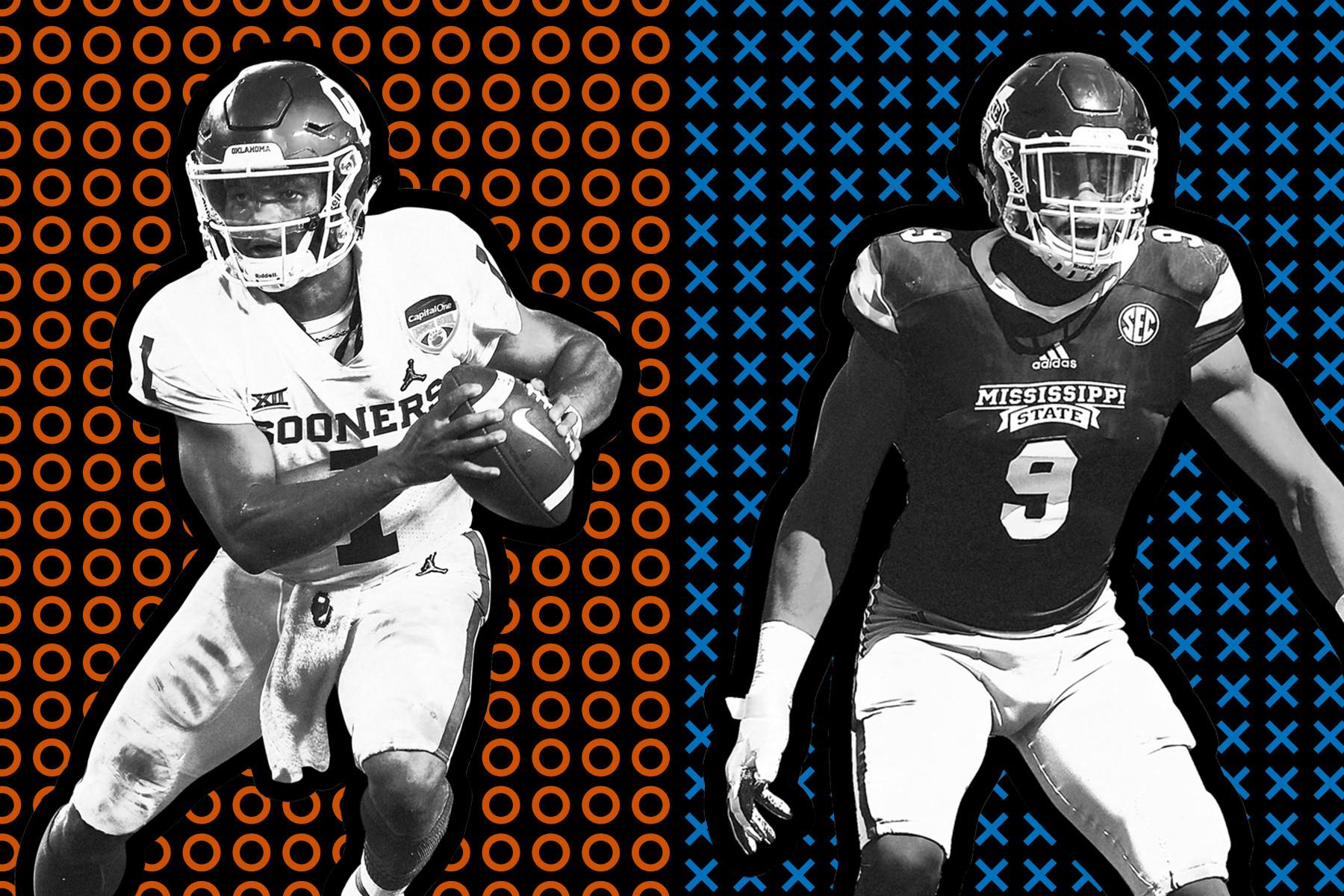In late October, Texas Tech head coach Kliff Kingsbury made a comment that reads awfully prophetic in hindsight. Kingsbury’s Red Raiders were playing the Sooners later that week, and Kingsbury heavily complimented Oklahoma quarterback Kyler Murray, as many coaches do before games to avoid giving their opponents any bulletin board material. Then he took it a step further.
“I’d take him with the first pick of the draft if I could,” Kingsbury told reporters. “I know he’s signed up to play baseball, but he is a dominant football player. I’d take him with the first pick.”
On Thursday, his new employer did just that. The Arizona Cardinals drafted Murray with the first pick in the NFL draft, capping one of the more unlikely strings of events in draft history: A year ago, the Cardinals traded a third- and fifth-rounder to move up five spots and draft UCLA quarterback Josh Rosen no. 10 overall. Ten months ago, Murray was drafted by the Oakland Athletics ninth overall in the MLB draft. Five months ago, Kingsbury was hired to be USC’s offensive coordinator a week after Texas Tech fired him as head coach. Four months ago, he shocked the football world by resigning from USC and accepting the head coaching job of the Arizona Cardinals. Thursday showed how quickly things can change in the NFL, and if the Kingsbury-and-Murray pairing is as exceptional as Arizona is hoping, change could be sweeping across the league, not just Arizona.
Statistically, Murray is one of the best quarterback prospects we’ve seen. In 2018, he was fifth in passing yards per game (311.5) and fourth in passing touchdowns per game (3.0) and tied for fifth in completion percentage (69.0). He led the nation in yards per attempt at 11.6, a figure virtually identical to his average depth of target, which is bananas. His passing efficiency rating, the college football version of passer rating, was the second-highest mark of all time, second only to Alabama’s Tua Tagovailoa, who set the all-time mark last year. His adjusted yards-per-attempt figure (13.0) was the highest in college football history. Murray finished with 1,001 rushing yards on 140 carries (7.15 yards per attempt), giving him the 15th-best yards-per-attempt figure in the nation among all qualified runners and by far the highest among all quarterbacks. Murray played only one season as Oklahoma’s starter, but by almost any metric it is among the finest seasons any passer has had in the sport’s history.
But Murray is even more impressive on the field than he is on paper. His release is quick, strong, and effortless. He is the most accurate passer, the most elusive runner, and the winningest player, from a personal and team perspective, of any quarterback in the draft. As The Ringer’s Rodger Sherman wrote this week, Murray’s pure passing gifts and running ability enhance one another to create a hybrid rarely seen in the sport.
If there’s a knock on Murray, it’s his height. Listed at 5-foot-10, he is the first quarterback drafted in the first round under 6 feet tall, never mind first overall. Yet 5-foot-11 Russell Wilson just became the highest-paid quarterback in NFL history, 6-foot Drew Brees is the all-time leader in passing yards, and Baker Mayfield, who is listed generously on the Browns’ website at 6-foot-1, was the best rookie quarterback in the NFL last year. The questions surrounding short quarterbacks have diminished in recent years, but a persistent one asks whether they can see over their offensive linemen, which can be a bigger problem than it seems. But in Kingsbury’s Air Raid offense, Murray will mostly be under shotgun, which makes it mostly a nonissue.
The real concern around Murray’s size could be his weight. He came in at 207 pounds at the combine but played far lighter than that in college, and the fear is he will be crushed by defenders who weigh 150 percent as much as he does. Yet the quarterbacks who’ve come before him have alleviated this concern too. Wilson has laid the blueprint for running quarterbacks not getting hurt: Never take a hit. He consistently slides or runs out of bounds to avoid contact each time he takes off, even if it means leaving a few yards on the field, and he has never missed a game in his NFL career. Murray’s college coach, Lincoln Riley, told ESPN’s Adam Schefter on Thursday that avoiding contact was one of his top skills, and making sure that translates to the NFL must be one of Kingsbury’s top priorities.
Beyond his size, one thing to watch for is how he’ll handle losing in the NFL. He went 42-0 in high school while winning three state championships in Texas, went 12-2 at Oklahoma and won the Heisman, and was selected in the top 10 of the MLB draft. Success has followed Murray at every turn. Meanwhile, here are the categories in which the 3-13 Cardinals finished last in 2018:
- Points
- Yards
- Yards per play
- First downs
- Passing yards
- Passing yards per attempt
- Net yards per pass attempt
- Passing first downs
- Rushing yards
- Rushing yards per attempt
- Third-down conversion percentage
- Fourth-down conversion percentage
- Field goals attempted
- Field goals made
- Time of possession per drive
- Scores per drive
It’s hard to blame the Cardinals for wanting to move on from that disaster of a campaign, and now the pressing question is what to do with Josh Rosen. The Cardinals could trade him during this draft, but after his disappointing rookie year and the Murray pick, the team would likely have to sell Rosen for pennies on the dollar. The Cardinals could hold onto Rosen and hope they get better value in August or September, but having both him and Murray in training camp could prove toxic, and it could damage Kingsbury’s coaching tenure before it begins. If Cardinals GM Steve Keim wants to look to NFL history as a guide, he won’t have much luck. Arizona is the second team since the 1970 NFL-AFL merger to draft a quarterback in the first round in back-to-back years. The only other team to do so was the Baltimore Colts, who drafted quarterback Art Schlichter fourth overall in 1982 then drafted John Elway no. 1 overall in 1983. Elway threatened to play baseball for the Yankees rather than suit for the Colts, and he was traded to the Broncos a week later. There is no modern football precedent for the situation Arizona is in.
Whether Murray and Kingsbury can turn around the Cardinals offense will be the single most interesting question entering the 2019 season. The Cardinals hit rock bottom in 2018, and perhaps they handed the reins to Kingsbury and his Air Raid offense, which is more religion than strategy, and now one of its foremost disciples has the perfect quarterback to carry it out. The college passing concepts Murray excelled at under Riley in Oklahoma—four verticals, mesh routes, hitch-seam, and Y-cross—should be featured heavily in Kingsbury’s playbook this year, and with receivers Larry Fitzgerald and 2018 second-rounder Christian Kirk, tight end Ricky Seals-Jones, and running back David Johnson, the Cardinals have the skill-position talent to make noise, even if their offensive line was the worst-graded pass-blocking unit in football by Pro Football Focus last year.
If Kingsbury and Murray turn the Cardinals around in 2019, not only will they have turned around the worst offense in football, but they’ll have provided the proof of concept that a new style can succeed at the highest level of the sport. It sounds silly to suggest that Arizona could be one of the better offenses in football a year after being the worst. But it also sounded silly when Kingsbury said he’d take Kyler Murray no. 1 back in October.

